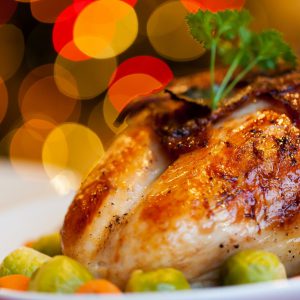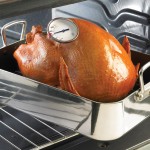by Samantha Kennedy | Oct 26, 2017

Photo credit:
www.Pexels.com (Creative Commons License)
According to the National Turkey Federation, 88% of American families eat turkey on Thanksgiving. That’s over 46 million turkeys! Served as the main dish, it is complemented by a variety of sweet and savory side dishes, many of which are family traditions made from recipes passed down through the generations.
Why do we eat turkey on Thanksgiving, anyway? Well, it’s kind of a funny story. While historians generally agree that turkey wasn’t eaten at the First Thanksgiving in Plymouth in 1621, it was well-documented that settlers often hunted wild turkeys as a source of protein, and subsequent celebrations often included turkey. After President Lincoln declared Thanksgiving a national holiday in 1863, turkey became a staple on many Thanksgiving tables.
When choosing a turkey, there are a few decisions to make. How many people will be eating? Will it be roasted, smoked, or deep-fried? Is frozen or fresh preferred?
When it comes to the proper size, a pound per person is a great rule of thumb. This includes the total weight of the bird, not just the meat. Also, the ratio of white meat to dark meat is about 7:3 (70% white meat, 30% dark), so if there are a lot of dark meat lovers around the table, additional thighs and drumsticks may need to be purchased.
Roasting is the most common way to cook a turkey. This method involves placing the turkey in a large roasting pan and cooking it in the oven slowly over several hours. The turkey is usually placed breast-side up in the pan and basted periodically to prevent drying. The lid or foil is also removed the last 30 to 45 minutes of roasting time to brown the skin and give the turkey that gorgeous presentation.
Vegetables such as potatoes, carrots, or Brussels sprouts may be added to the roasting pan to cook concurrently. For best results, roast the turkey at 325˚F for 15 minutes per pound. For example, a 15 pound turkey would take 3 hours and 45 minutes.
Smoked turkeys are usually fully cooked (read the label to be sure) and just need to be reheated. Keep in mind, smoking is done to impart flavor and does not increase the turkey’s shelf life. Follow the instructions on the package to properly reheat the turkey.
Deep-fried turkeys are submerged in very hot oil and cook more quickly than roasted turkeys. Turkeys can be deep fried in a very large stockpot or in a designated turkey fryer. Only use enough oil to cover the turkey. Too much oil can cause a fire or overflow when the turkey is added to the cooker.
To determine the amount of oil, place the turkey in the cooker and add enough water to cover the bird. Then remove the bird. The water line will indicate the level of oil needed to adequately fry the turkey. For best results, let the turkey warm to room temperature before frying, and fry the turkey for 3 minutes per pound plus 5 minutes per bird.
Remember, the size of the cooker will dictate the size of the turkey. The turkey should fit easily without being forced. Wedging a turkey into a cooker that is too small could cause uneven cooking, or worse, a fire.
As for frozen versus fresh, there is no difference in flavor. However, frozen turkeys can be purchased months in advance and kept frozen until needed. Fresh turkeys should be purchased no more than two days in advance for maximum safety and freshness.
The safest way to thaw a frozen turkey is in the refrigerator. This will take pre-planning. The general rule of thumb is 24 hours of refrigerator thawing per 5 pounds. For example, a 15 pound turkey should take 3 full days (72 hours) to thaw completely.
However the turkey is cooked this year, have a Happy Thanksgiving!
by Judy Corbus | Nov 26, 2013
Normal
0
false
false
false
EN-US
X-NONE
X-NONE
/* Style Definitions */
table.MsoNormalTable
{mso-style-name:”Table Normal”;
mso-tstyle-rowband-size:0;
mso-tstyle-colband-size:0;
mso-style-noshow:yes;
mso-style-priority:99;
mso-style-parent:””;
mso-padding-alt:0in 5.4pt 0in 5.4pt;
mso-para-margin-top:0in;
mso-para-margin-right:0in;
mso-para-margin-bottom:8.0pt;
mso-para-margin-left:0in;
line-height:107%;
mso-pagination:widow-orphan;
font-size:11.0pt;
font-family:”Calibri”,”sans-serif”;
mso-ascii-font-family:Calibri;
mso-ascii-theme-font:minor-latin;
mso-hansi-font-family:Calibri;
mso-hansi-theme-font:minor-latin;}
 The highlight of many Thanksgiving meals is the turkey –juicy, golden brown, and delicious! Before and after it reaches the table, however, follow these steps to reduce your guests’ risk of foodborne illness.
The highlight of many Thanksgiving meals is the turkey –juicy, golden brown, and delicious! Before and after it reaches the table, however, follow these steps to reduce your guests’ risk of foodborne illness.
Thaw the turkey safely:
- In the refrigerator at 40oF or below– allow 24 hours for every 5 pounds. Place the turkey in a container to prevent the juices from dripping on other foods. Cook within 1-2 days.
- In cold water – submerge the turkey in a leak-proof plastic bag in cold water. Change the water every 30 minutes until the turkey is thawed; allow 30 minutes per pound. Cook turkey immediately after it is thawed.
- In the microwave oven – check your owner’s manual for specific instructions for defrosting a turkey. Plan to cook it immediately after thawing because some areas of the food may become warm and begin to cook during microwaving. Holding partially cooked food is not recommended because any bacteria present would not have been destroyed.
For roast turkey, set the oven temperature no lower than 325°F. For optimum safety, cook stuffing in a casserole. If stuffing your turkey, mix ingredients just before stuffing it; stuff loosely. Additional time is required for the turkey and stuffing to reach a safe minimum internal temperature.
APPROXIMATE COOKING TIMES
(325°F oven temperature)
UNSTUFFED (time in hours)
- 4 to 6 lb. breast — 1 1/2 to 2 1/4
- 6 to 8 lb. breast — 2 1/4 to 3 1/4
- 8 to 12 lbs. — 2 3/4 to 3
- 12 to 14 lbs. — 3 to 3 3/4
- 14 to 18 lbs. — 3 3/4 to 4 1/4
- 18 to 20 lbs. — 4 1/4 to 4 1/2
- 20 to 24 lbs. — 4 1/2 to 5
STUFFED (time in hours)
- 8 to 12 lbs. — 3 to 3 1/2
- 12 to 14 lbs. — 3 1/2 to 4
- 14 to 18 lbs. — 4 to 4 1/4
- 18 to 20 lbs. — 4 1/4 to 4 3/4
- 20 to 24 lbs. — 4 3/4 to 5 1/4
Use a food thermometer to ensure your turkey is safe. Insert thermometer in the innermost part of the thigh, wing, and the thickest part of the breast. The turkey is safe at 165°F. Let the bird stand 20 minutes before removing stuffing and carving.
After the big meal, perishable foods should not be left out of the refrigerator for more than 2 hours. Remove all stuffing from the turkey cavity immediately and refrigerate. Cut turkey into smaller pieces and refrigerate. Slice breast meat; legs and wings may be left whole. Refrigerate potatoes, gravy, and vegetables in shallow containers.
Refrigerator-stored cooked turkey and cooked dishes and gravy should be eaten within 3 to 4 days. Reheat leftovers thoroughly to 165°F or until hot and steaming; bring gravy to a rolling boil. In the microwave oven, cover food and rotate dish so it heats evenly.
For longer-term storage, freeze food in airtight freezer containers or bags and use within 4 to 6 months for best quality.
Questions on Thanksgiving Day?
Ask Karen, the virtual food safety representative, is available 24/7 at AskKaren.gov. Weekdays between 10 a.m. and 4 p.m. ET, the USDA Meat and Poultry Hotline is available at 1-888-MPHotline (1-888-674-6854). On Thanksgiving Day, the Hotline will be open from 8:00 am to 2:00 pm Eastern Time.
Happy Thanksgiving!
Source: USDA Food Safety and Inspection Service, www.fsis.usda.gov.


